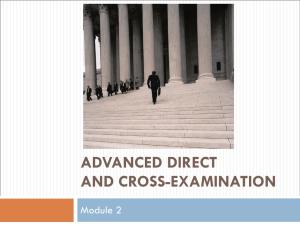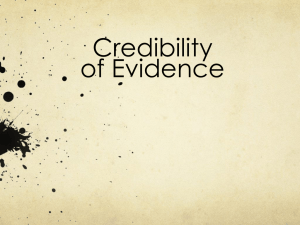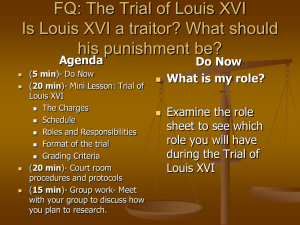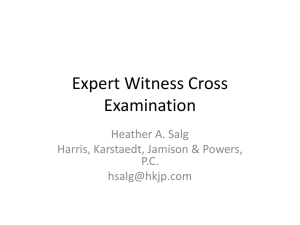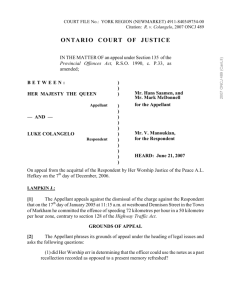Advanced Direct and Cross
advertisement
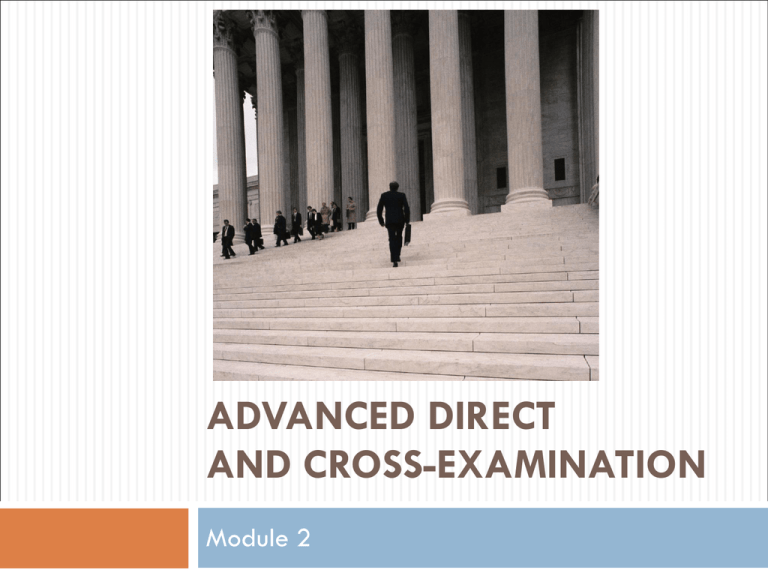
ADVANCED DIRECT AND CROSS-EXAMINATION Module 2 Organization Of Discussion Direct examination techniques Refreshing recollection, past recollection recorded, looping for emphasis, saving topics for re-direct examination Cross-examination techniques Prior inconsistent statements, dealing with improving memories, attacking character for truthfulness, impeaching with felony convictions, bringing out general bias Rehabilitation Reviving your witness after character, bias, or motive attacks. Direct Examination Refreshing Recollection Steps: First, try to see if witness can refresh him/herself If not, what else might help refresh his/her memory? Basic method: Will this document help? Witness looks at it. What’s your answer now? Mechanics of Refreshing Think of the foundation as a grocery list First establish that the witness has forgotten something Then establish that there is something that would help him or her remember Ask to approach with the document Show the witness the document Ask the witness to read the document and then put it down Retrieve the document Ask if the witness’s memory is refreshed Repeat the question Mechanics, Continued Retrieve it Ask again Interesting foundation? Recorded Recollection What if the witness still does not remember? Witness’s memory cannot be refreshed The out of court statement, or hearsay, can be admitted as a hearsay exception Past recollection recorded, C.R.E 803(5) Same foundation as refreshing recollection except one big difference Recorded Recollection Hearsay Requires a hearsay exception CRE 803(5): Based on reliability CRE 803(5) Requirements: A memorandum or record made by, or adopted by, the witness Witness had knowledge, but now has insufficient recollection Adopted or made when knowledge was fresh Recorded Recollection Same foundation as refreshing recollection, BUT must include questions about when and why the document was made or adopted. Document read into the record NOT admitted Again, interesting foundation Looping Repeating an answer Instead “loop” Example: Question: “Please describe the car.” Answer: “It was a red sports car.” “How fast was the red sports car going?” Saving Topics Redirect: Purpose is to rehabilitate or rebut information brought out on cross Some topics must be saved: Rehabilitation with prior consistent statement or evidence of truthful character Optional: Strategic use of topics that may be damaging or risky Be careful. If cross-examination is waived, there is NO redirect Also redirect is limited to areas that were explored in cross examination May not introduce new topics just because you forgot to ask about them during your direct examination Cross Examination Prior Inconsistent Statements A common method of impeaching a witness: That is not what you said before Hearsay? Impeachment statements are not hearsay: not being offered for the truth The Three Cs: Confirm, Credit and Confront Confirm Confirm Did you say on direct examination that …? Show the jury/bench you do not believe it Body, tone and language Credit Seek to bolster the creditability of the prior statement as much as possible Ways to credit the prior statement: Timing Knowledge of importance of statement Oath or other formalities Confront Impeachment requires that you confront the witness with her prior statement Methods for confrontation “Improving” Testimony Another type of impeachment problem Witness on the stand starts to testify to “New facts” There is no “inconsistent” statement with which to impeach Sometimes referred to as an impeachment by ommision Prior inconsistent statement foundation with one addition Build up creditability of the prior statement, just as done before AND build up the importance of the new fact Showing that it is so important, no reasonable person would have omitted it And yet, there is no evidence of it in prior statement Confrontation: Hand prior statement to witness Ask witness to point out where new fact is included in prior statement Witness is unable to do it. Impeaching Character Character is generally inadmissible C.R.E. 404(a) Character of a witness for truthfulness C.R.E. 404(a)(3) and C.R.E. 608 Truthful Character of Witness Evidence of truthful character admissible only after attack on truthfulness But only after attack on truthfulness Used as rebuttal evidence Opinion and/or reputation evidence C.R.E 608(b) Impeaching With Conviction C.R.S. §13-90-101 Credibility of any witness may be attacked with his or her felony convictions Any felony conviction can be used (not just crimes of truthfulness) But different rules for civil and criminal cases Civil: Can only use felony convictions that are less than 5 years old Business Records C.R.E. 803 (6) Records of regularly conducted activity Witness Records made contemporaneously Kept in course of regular business activity Regular practice to make such reports Re-Direct Examination Rehabilitating Witnesses Evidence of prior consistent statements Evidence of truthful character Difficult Witnesses Two Types Of Witnesses The sympathetic witness The uncooperative witness Sympathetic Witnesses Theory of the case to eliminate attack Empathy Be up front Uncooperative Witnesses Good Theme And Good Questions Repeating Clarifying Reversing So The Answer Is Yes Using The Hand Asking For Help Good Questions The most important cross-examination technique – for all witnesses – is to ask good questions Leading questions One fact per question Build incrimently Build in a logical order Can be a declarative statement Avoid conclusions Avoid adjectives “You made a referral in this case” “The referral was for my client, Ms. Jones” “The referral was for Ms. Jones to take urine analysis, or UAs” “The referral was for urine analysis at Whiz Quiz” “You made this referral on October 10th” “You made the referral by calling Whiz Quiz……” Repeating Let me ask you again Will the court reporter read the last question Perhaps I was not clear, what I am asking is Clarifying I am not asking you about X, I am asking you We can talk about X in a moment, all I am asking you right now is You can talk about X with opposing counsel, all I am asking you right now is So The Answer Is Yes A variation of clarifying Reversing Using an opposite fact to get clarity Using The Hand Asking For Help When is it okay, and how do you do it? Making A Deal Good idea? Bad idea? Expert Witnesses Expert Witness during the PreTrial Phase How to select your own expert How to use your own expert Other strategies to use during pre-trial when anticipating expert testimony Educating yourself about the issues Adequate discovery Direct Examination Qualifying the expert: C.R.E. 702 Offering the expert Bases of the opinion: C.R.E. 703 Explaining the opinion: C.R.E. 703 and 705 Offering the opinion Qualifying The Expert C.R.E. 702: “a witness qualified by knowledge, skill, experience, training or education” Qualifying The Topic C.R.E. 702: “scientific, technical or other specialized knowledge [that will help the jury] understand the evidence or determine a fact in issue” Qualifying The Process NO F.R.E. 702 equivalent in Colorado…. People v. Shreck, 2 P.3d 68 (2001) Reliable scientific principles Witness qualifications Helpfulness to the trier of fact Opinion Elicit the opinion from the expert Based on the education, training and methods you have described, have you reached a conclusion (with a reasonable degree of scientific certainty) What is that opinion Explanation Basis of the opinion – admissible? Opinion Elicit the opinion from the expert again! Technically, it has been asked and answered Most judges will allow it CROSS-EXAMINATION of the Expert Use their expert to prove or build your theory of the case Weaken their expert by using new facts or bad facts from your case Get Your Own Expert Trying to “out-expert” their expert is a mistake unless you have your own Your expert helps you Understand the topic Prepare cross-examination questions Present opposing testimony New And/Or Bad Facts GIGO Garbage in, garbage out Objections Objections are the fun part of trial work, although they tend to be underutilized in our dependency and neglect cases. Let’s look at objections in detail. Overview Gotta make them Gotta refrain from overdoing How To Object CRE 103(a)(1) Timely and specific Basic objection Objection, Speaking objection Can hearsay. land you in hot water Plain English objection So the jurors understand Making A Record Offer of Proof: CRE 103(a)(2) Anticipating Objections Motions in limine Improper form of the question


